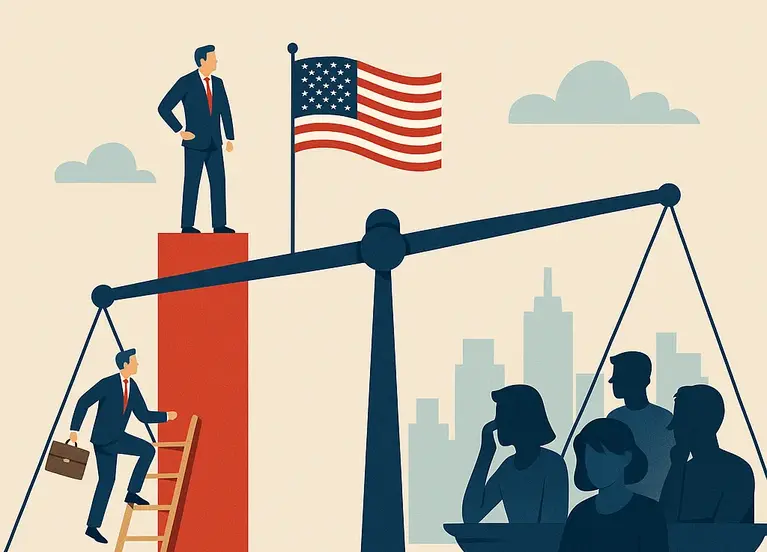U.S. Job Market in 2025 is undergoing a dramatic transformation as employers reclaim control. After several years of worker-led empowerment from wage demands and remote flexibility to cultural influence the labor market is now singing a different tune. Rising interest rates, global instability, labor saturation, and technological disruption have all played a role in shifting the power dynamic back toward companies.
While some workers saw the COVID-era job market as the beginning of a long-term labor renaissance, what has transpired is a strategic correction—a return to employer dominance, marked by tighter control, fewer perks, and a renewed focus on bottom-line productivity.
Table of Contents
From “Great Resignation” to “Great Realignment”
In 2021 and 2022, more than 47 million Americans voluntarily left their jobs during the so-called “Great Resignation.” Companies bent over backward to retain staff, offering hybrid work models, sign-on bonuses, and wage hikes. Job seekers had leverage. But that era was short-lived.
By mid-2024 and into 2025, a convergence of forces—including economic headwinds, layoffs in key industries, and an AI revolution—began to reset the balance.
Key Forces Behind the Power Shift:
- Economic Volatility: With the Federal Reserve tightening monetary policy to combat inflation, businesses have pulled back on aggressive hiring and begun budget trimming.
- Tech Layoffs: Major firms like Amazon, Meta, and Google have shed thousands of jobs, signaling that growth-at-all-costs is over.
- Surging Applicant Pools: As post-pandemic workers re-enter the job market, the supply of labor has increased faster than demand in many sectors.
- AI and Automation: Sophisticated technologies are reducing the need for human labor in many white-collar and operational roles.
The Return of Mandates: Office Culture Reinforced
In 2023 and 2024, hybrid work was considered a non-negotiable part of job offerings. By 2025, the tone has shifted. Employers are enforcing stricter return-to-office (RTO) mandates—often without apology.
Big players like JPMorgan Chase, Amazon, and Meta now require most staff to be physically present three to five days per week. The rationale? Boosting collaboration, re-establishing office culture, and enhancing oversight. But critics argue it’s a not-so-subtle way to exert control and edge out less “visible” employees.
For job seekers, this means adapting to a landscape where remote-first roles are rarer and competition for flexible jobs is stiffer than ever.

Hiring Is Slowing—But Expectations Are Not
The labor market is tightening. Employers have the luxury of being more selective, and they’re using it. Across industries, the number of applications per opening has surged. Hiring managers now expect:
- Advanced, multi-disciplinary skills
- Experience with AI tools and platforms
- Proven remote productivity, if flexibility is allowed
- Faster onboarding and fewer training needs
Many firms are filling fewer roles with higher-performance expectations, a trend some analysts are calling “consolidated headcounting.”
College Degrees Are Losing Clout—But Credentials Matter
While employers are regaining influence, they’re also shifting their criteria. Traditional four-year degrees are not as valuable as they once were. Instead, skills-first hiring is becoming dominant—especially in tech, marketing, and analytics.
Yet the demand for credentials—not necessarily degrees—remains high. Candidates with specialized certifications, such as Google Data Analytics or AWS Cloud Practitioner, often edge out degree-holders with little practical experience.
In short: hiring is more rigorous, more targeted, and more employer-driven than ever before.
📉 Navigating the U.S. Job Market in 2025
The balance of power is shifting back to employers in today’s evolving workforce landscape.
With rising interest rates, global uncertainty, and rapid technological disruption, job seekers must adapt to a more competitive and employer-driven market.
WhatJobs connects you with roles that offer security and long-term growth—even as the market transforms.
👉 Explore top U.S. job opportunities now and stay ahead in a changing market.Job Insecurity Is the New Norm
One consequence of this employer-dominant market is a rise in job insecurity, even among full-time employees. Layoffs, quiet performance reviews, “stack ranking,” and minimal wage growth are becoming more common.
According to a recent Gallup report:
- 42% of American workers feel less secure in their current roles than they did a year ago.
- Only 28% believe they have leverage to negotiate raises.
This insecurity has given employers a stronger negotiating position when it comes to compensation, location, and even company culture compliance.
Perks Fade as Profit Margins Matter
During the height of the labor shortage, some companies famously offered:
- Unlimited PTO
- Wellness stipends
- Summer Fridays
- Free home-office equipment
- Tuition reimbursement
In 2025, many of these perks are being rolled back or quietly discontinued. Why? Because businesses are under pressure to manage tighter margins, appease shareholders, and demonstrate operational efficiency in an uncertain economy.
This rollback signals a philosophical shift: jobs are a transaction again, not a lifestyle.
Who Is Thriving in This Market?
Not everyone is losing out. Workers who have invested in in-demand skills or who occupy mission-critical roles are doing well. These include:
- AI and machine learning engineers
- Cybersecurity experts
- Healthcare professionals (especially RNs and behavioral therapists)
- Skilled trades (electricians, HVAC technicians, machinists)
For these individuals, demand remains strong—and so does the leverage. Employers continue to woo top-tier talent in these fields with competitive offers, though still within more cautious parameters.
The Psychological Toll: Control Without Compassion?
In this power shift, something intangible is being lost: employee morale.
Mental health experts warn that the renewed dominance of employers—when exercised without empathy—risks triggering disengagement, burnout, and resignation spikes in 2026. Already, surveys indicate a decline in workplace satisfaction across sectors.
Managers are being urged to walk a fine line: assert necessary changes, but do so with transparent communication, feedback loops, and personalized support.
What Job Seekers Should Do Now
Navigating this employer-favored market requires adaptability. Here’s how workers can maintain a competitive edge:
1. Invest in Portable Skills
Prioritize abilities like data analysis, leadership, digital fluency, and cross-functional collaboration. These are valuable across roles and sectors.
2. Maintain an Active Digital Presence
Keep your LinkedIn updated. Share thought leadership. Engage in industry discussions. Employers are now scouting passive candidates through social platforms more than ever.
3. Upskill Frequently
The average “shelf-life” of digital skills is now just 3–5 years. Invest in micro-certifications, workshops, and cross-training to stay relevant.
4. Negotiate Smartly
Don’t just chase salary. Ask about role stability, manager tenure, team structure, and flexibility. The strongest candidates are those who evaluate culture fit, not just compensation.
FAQs
Q: What triggered the shift back to employer dominance?
A: A mix of post-pandemic normalization, economic tightening, AI automation, and labor market saturation has allowed companies to regain leverage.
Q: Are return-to-office policies here to stay?
A: For the most part, yes. While hybrid models will persist in some industries, full flexibility is becoming rarer as employers push for consistency and oversight.
Q: Is the job market still strong in 2025?
A: It’s still functional but less employee-friendly. Hiring is slower, job security is waning, and upward mobility has stalled in many fields.
Q: Should I go back to school to stay competitive?
A: Not necessarily. Focus on skill-building through targeted courses and credentials rather than expensive, time-consuming degrees—unless required for your profession.
Final Thoughts
In 2025, the U.S. job market has re-centered itself around employer priorities. The power once held by employees during the “Great Resignation” has receded, replaced by leaner hiring practices, tighter control, and a no-frills corporate mentality. This doesn’t signal the end of worker influence, but it does mean the next era of employment will require strategy, adaptability, and continual skill investment.
For companies, the challenge is to balance authority with empathy. For workers, it’s time to embrace the reality of a transformed market—and evolve accordingly.




